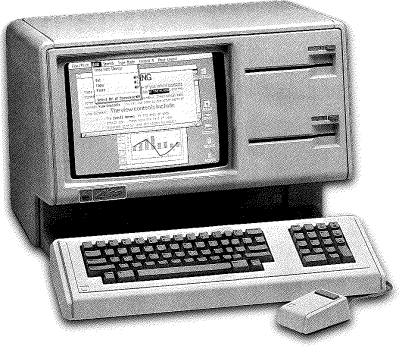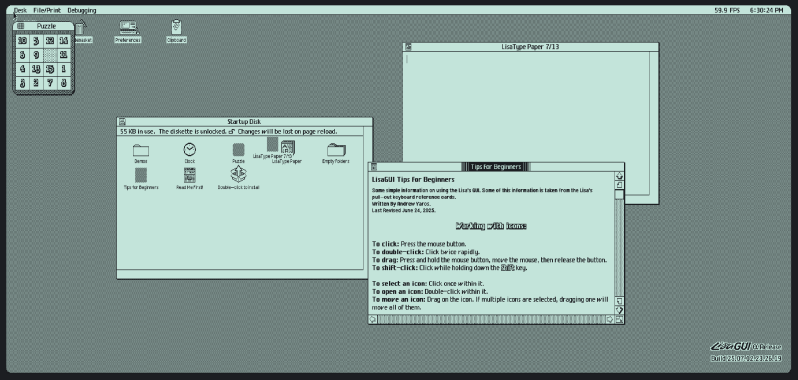Sure, Apple’s Lisa wasn’t the first computer released with a graphical user interface — Xerox was years ahead with the Alto and the Star workstation — but Lisa was the first that came within the reach of mere mortals. Which doesn’t mean many mortals got their hands on one; with only about 10,000 sold, they were never common, and are vanishingly rare nowadays. Enter [Andrew Yaros], who has graced the world with LisaGUI, an in-browser recreation of the Lisa Office System in Javascript.
Lisa’s GUI varies from modern conventions in a few interesting ways. For one, it is much more document-focused: if you double-click on LisaType, you do not start the program. Instead you “tear off” a document from the “pad” icon of LisaType, which you can then open with another double click. The desktop is also not a folder for files to live permanently, but a temporary space. You can “set aside” a file to the desktop, but its home on disk is unchanged.
 Unlike the family of Mac emulators, LisaGUI does not purport to be a perfect replica. [Andrew] has made a few quality-of-life improvements for modern users, as well as a few innovations of his own. For instance, menus are now “sticky”– on the Lisa, you had to hold down the mouse to keep them open, and release on the appropriate entry. LisaGUI leaves the menu open for you to click the entry, as on a later Macintosh.
Unlike the family of Mac emulators, LisaGUI does not purport to be a perfect replica. [Andrew] has made a few quality-of-life improvements for modern users, as well as a few innovations of his own. For instance, menus are now “sticky”– on the Lisa, you had to hold down the mouse to keep them open, and release on the appropriate entry. LisaGUI leaves the menu open for you to click the entry, as on a later Macintosh.
Obviously the menu bar clock and FPS counter are not native to the Lisa; nor is the ability to theme the icons and change (1-bit) colour palettes. The ability to draw unique icons to assign to documents is all [Andrew], but is something we wish we had back in the day. He also makes no attempt to enforce the original aspect ratio, so you’ll be dragging the window to get 4:3 if that’s your jam.
Right now it does not look as though there’s much original software aside from LisaType. We would have loved to see the famous LisaProject, which was the original “killer app” that led NASA to purchase the computer. Still, this is an Alpha and it’s possible more software is to come, if it doesn’t run afoul of Apple’s IP. Certainly we are not looking too hard at this gift horse’s chompers. What’s there is plenty to get a feel for the system, and LisaGUI should be a treat for retrocomputer enthusiasts who aren’t too anal about period-perfect accuracy.
We stumbled across this one in a video from [Action Retro] in which he (the lucky dog) also shows off his Lisa II, the slightly-more-common successor.
















Funny: The NCR PC4 series looked quite like Lisa and won German Design Award of 1985.
https://www.oldsilicon.com/ncr-pc4
Also, the Lisas had a second life as Macintosh XL computers.
By help of various versions of MacWorks software, unmodified Macintosh software could be used.
An optional ROM change fixed aspect ratio, but removed ability to boot into Lisa OS (LOS).
MacWorks can be run in an early, special version of LisaEm, I believe.
I worked with an ICL Perq in the very early 80s. Lisa isn’t a granddaddy. More a bastard child.
Funnily enough my Lisa came from ICL Road One
granddaddy of all macs, not all gui computers. read the title.
when i had several lisa 2/10, i was appalled by how few applications were available for them and seldom turned them on. the 400k floppy drive didn’t help either. I sold them all but I still have my first mac SE.
My first desktop computer was a Tandy MSDOS machine. I lived in textmode land, I dreamed about having a real OS some day. I used the drawing program to make fake screenshots of what I called “System 7 OS” which was mainly inspired by Windows 3.1 and what I thought Macs OS looked like.
Lisa is wild bc the desktop conventions on display were years before standard consumer adoption. Jobs cultdom bothers me, but Apple was on to some strong ideas for the future. Gates and Jobs gave me expectations for what modern computer use could be.
“Jobs cultdom bothers me, but Apple was on to some strong ideas for the future.”
Agreed. I feel same about Torvalds and its creation, by the way.
Fanatism is never good, I think. People should continue to think on their own, rather.
Linus is far and above Gates in technical ability. Gates is a mere broker, a salesman. Linus shade is uninformed. Linux is not a fanatical concept, its a strong ecosystem of tools for all latitudes of hardware use. I think you are making comparisons which through the lens of your value system concerning humans of stature and fame are subjective. Linus is a Polish immigrant, he is a diving enthusiast, he is not obscenely wealthy like many of his peers, his contributions in project management are rife with controversy but provedly he has guided the Kernel with great focus. He has a unique leadership skillset which I neither love nor hate, and this is not a consideration for me. Most products that I enjoy are made by teams I certainly would not be succesful in. But through additive properties of human effort I shall enjoy the result of others efforts without regard to recency biases.
Historical figures such as Stalin, Lenin, Mussolini and Hitler had fans, too.
And these historical figures didn’t claim to be bad guys, but free the people and make a better future.
It’s not good if people build up a cult of personality, it can get its own dynamic which can get out of hand quickly.
Remaining a bit reserved and sceptical torwards them isn’t unwise, thus, especially if the masses thend to have one same opinion.
I recommend reading “the wave”, it gives an idea how badly things can escalate if individuals are being glorified.
On a second thought, perhaps its important to being able to separate the creator and its creation, as well.
Leader figures create a symbol of their own, too, which isn’t necessarily exactly a representation that’s in harmony with the person’s true character.
You must be a blast at parties.
Gates had a strong technical background. Don’t let your resentment against Microsoft or Windows prevent you from telling the truth, as it also takes away any credibility to your message. I write this as a 100% Linux user myself since version 2.x of the kernel (although briefly used 1.x too).
Nope. He’s Finnish and got American as 2nd citizenship.
Which AI did you use to write the above?
Won’t be authentic unless it crashes every hour or so.
Even the first Macintosh would crash frequently and given it had only a floppy disk for permanent storage, often led to a loss of work and a very angry user.
I would have crashed too, if I had merely 128KB of memory and no virtual memory.
The original Macintosh was unusable without a memory upgrade.
Most applications didn’t start or ran out of memory midway.
256KB was planned expansion, but 512KB got a reality.
Likewise, original Amiga A1000 had too little memory.
There’s a reason it had a hidden RAM slot behind the front bezel.
Both computers were sold with underpowered memory expansion,
to get them out to the customers before proper memory expansion was financially feasible.
Millions of people did a lot of useful work with a Z80 and 64k.
Hi! Yes and no.
Powerful operating systems need powerful OSes, too.
Especially RAM is important so they can “think”.
Let’s take OS/2 and Vista.
Vista had a file compression/decompression feature meant to improve network throughput.
OS/2 had the ability to run separate copies of Windows 3.1x, so each Windows application had its own.
This gave illusion of preemptive multitasking.
Cool isn’t it? Unfortunately, it needed PCs only power users had.
Mortals, ordinary people came to the false conclusion that both OSes are just bloated.
Or let’s take C64. Coding by hand in ASM 6502 surely is fun, but..
GEOS supported both Commodore REU modules and cheaper geoRAM modules for a reason.
Because user data requires RAM. Bitmap data, formatted text-files, animations, sampled sounds etc.
https://de.wikipedia.org/wiki/GeoRAM#/languages
https://en.wikipedia.org/wiki/GeoRAM
About Z80.. Well, yes and no.
Power users on IBM PCs used to run CP/M-80 via emulation.
By using a NEC V20/V30 they got i8080 emulation mode.
It had a little known feature: separate 64KB space for code and data.
Likewise, MP/M and MP/M II on real hardware had been used by developers to access large amounts of memory via bank-switching (512 or 2MB total?).
It was the power user version of CP/M, even before that term was coined.
CP/M Plus (aka CP/M) had supported bank-switching, too.
64KB of memory “weren’t enough”, depending on how we look at it.
*need powerful PCs, too.
*CP/M Plus (aka CP/M 3)
Sorry for the typos.
I had to rewrite the whole text because the reply form had an error and everything I typed was lost.
But maybe I rightfully deserved that! 🥲
https://en.wikipedia.org/wiki/Commodore_REU
The grandaddy of Macs had “Xerox” on the front of it…
Apple paid Xerox (in pre-IPO stock). Nothing was stolen. A deal was made, money exchanged hands. It’s not Apple’s fault Xerox couldn’t see beyond their copier business. Y’all need to get over it.
Tandy’s Deskmate was a better UI than Lisa. I still don’t like MacOS.
Back in the day, the Tandy was able to run GEM, too. Which was the PCs answer to MacOS (System Software).
The version that shipped fore free with Amstrad/Schneider PC1512 and PC1640 was mostly PC compatible and gained some market share.
It still ran withoutmuch doing on ordinary PCs in plain CGA (640×200) and via keyboard, at very least.
Higher resolutions and mouse support did depend on driver support for the given machine.
Using a shrink-wrapped retail copy of GEM was an option, too, of course.
GEM was “there” in as early as 1985 and GEM Desktop 1 was still very much like Macintosh Finder.
Later GEM versions could still run GEM Desktop 1 executable, so it was possible to undo the restrictions applied on GEM.
Lisa would be a grandmommy.
I need C version and SDL2